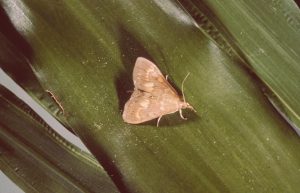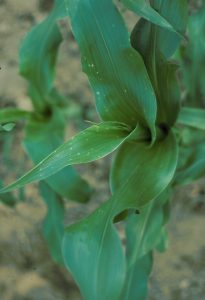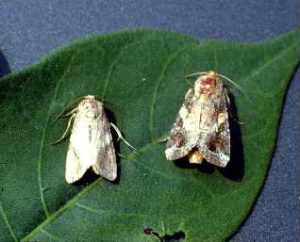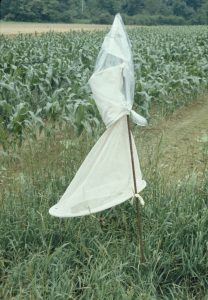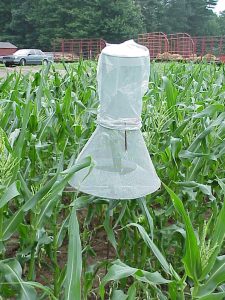Sweet Corn IPM Newsletter No. 1 – June 29, 2018
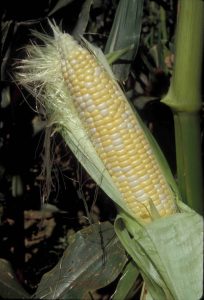 Sweet Corn IPM Newsletter No. 1 – June 29, 2018
Sweet Corn IPM Newsletter No. 1 – June 29, 2018
Click on photos to enlarge.
2018 SWEET CORN PEST SEASON BEGINS!
European Corn Borer Active in Early Fields
The 2018 University of Maine Cooperative Extension Integrated Pest Management (IPM) program for sweet corn is underway. More than twenty volunteer farms are serving as pest monitoring and demonstration sites, with fields in North Berwick, Wells, Dayton, Cape Elizabeth, New Gloucester, Poland Spring, Auburn, Lewiston, Sabattus, Nobleboro, Monmouth, Wales, Wayne, Oxford, Farmington, Levant, Stillwater, Garland and East Corinth. We are setting up pheromone traps at these locations to monitor the adult (moth) stages of European corn borer, corn earworm and fall armyworm, and we are scouting the fields for feeding injury by insect larvae. We will be sharing the information we collect along with management recommendations through this newsletter blog.
SITUATION
A very dry spring has got early corn off to a quick start, in spite of variable temperatures. Early plantings in southern Maine and plots started under plastic or row covers are mostly at pre-tassel, although we have seen a few tassels, and some silking corn in a transplanted field. Late fields are starting to emerge. Early scouting has shown some European corn borer activity in pre-tassel corn, but no damage has been over the spray threshold. With warmer temperatures expected we can expect to see increased activity in the coming days, and weather coming up from the south may also bring our first corn earworm of the season.
European corn borer: Pheromone traps for moths are set up in the grassy borders around cornfields. We have begun scouting pre-tassel to tasseling fields in southern Maine, and found some early feeding damage in Oxford, Farmington, Wayne and Nobleboro. To monitor corn borer, we scout 100 corn plants in each field, examining twenty plants in a row at five different locations. This provides a good estimate of the total amount of injury in a field.
- European Corn Borer Moth; photo by David Handley
- European Corn Borer Damage; photo by David Handley
In the early stages, European corn borer feeding damage looks like small “pinholes” in the leaves. Whorl stage corn only needs to be sprayed if fresh feeding injury is found on 30% or more of the plants scouted in a field. Once the corn reaches the pre-tassel stage, the control threshold is lowered to 15% because larvae feeding on the later stages are more likely to move into the ears. On the tassels, feeding damage first appears as chewing and brown waste found in the small florets. After the tassel has emerged from the whorl, the larvae chew into the stalk just below it, often causing the tassel to fall over. Sprays during the pre-tassel stage, when both moths and larvae are present, target the larvae before can they move into the protection of the stalks and ears. Good spray coverage of the entire plant provides the most effective kill of larvae as they move from one part of the plant to another. Rotating the type of insecticide used also improves control. Materials registered for controlling European corn borer include Bacillus thuringiensis products (XenTari®, Dipel DF®), Avaunt®, Coragen®, Warrior®, Lannate®, Baythroid®, Asana®, Radiant®, Delta Gold®, Mustang®, Sevin XLR® and Intrepid®. Newly hatched European corn borer larvae are very small and translucent with shiny black heads. They emerge from small egg masses that look like a tiny clump of overlapping fish scales on the undersides of corn leaves. European corn borer overwinters in Maine, and is usually the first pest to become a significant problem.
Growers should start scouting whorl stage corn for feeding injury now. Once corn reaches the silk stage, sprays may be based on the number of corn borer moths caught in pheromone traps rather than feeding injury. European corn borer moths will lay eggs on flag leaves of silking corn, and the larvae can move into the ears without leaving visible feeding injury that would be noticed when scouting. If more than five moths are caught during a week in a field with silking corn, a spray is recommended. Varieties of corn genetically modified to produce the Bt toxin (e.g. Bt corn, Attribute® varieties), should not need to be sprayed to control European corn borer.
Corn earworm: We have set up pheromone traps around the state for corn earworm moths. Corn earworm generally appears in Maine in early July, but the actual date varies greatly. The arrival of this pest is only a concern for fields with corn in the silk stage. Fields not yet in silk do not need to be protected from corn earworm. When corn earworm moths are caught at a site, all silking corn in the fields should be protected with a spray. These moths lay eggs on the fresh silks, and the larvae move directly into the ears of corn. When corn earworm moths cannot find silking corn to deposit their eggs on, they may lay eggs on the leaves or tassels of younger corn. The larvae will feed on the foliage and tassels, similar to armyworm, until the ears become available. When larvae are found feeding on younger corn, the damage is accounted for, along with any borer or armyworm damage, to determine if a spray is warranted.
- Corn Earworm Moth; photo by David Handley
- Fall Armyworm Moths (female right, male left); photo by James Dill
Fall armyworm: This is usually the last serious corn insect pest to arrive in Maine. The moths fly in from southern over-wintering sites, and tend to lay their eggs on the youngest corn available. The young larvae chew large, ragged holes in the leaves, and may bore into developing ears. Larvae can also move into the ears through the silk channel, behaving similarly to corn earworm. Pheromone trap catches will indicate if there is a threat to silking corn. However, corn is often on a spray program for corn earworm when fall armyworm is present, and both insects should be controlled. For the past two years, fall armyworm moths arrived in Maine early in the season, and were often more of a threat than corn earworm. We will be watching fall armyworm closely this year to see if this new, unfortunate trend continues.
Common armyworm: Be on the lookout for reports of common armyworm attacking silage corn, alfalfa and hayfields. Common armyworm can become active as early as April and can become a problem in early planted sweet corn. However, if the corn is established, it will outgrow the injury, as the caterpillars will pupate before the ears develop. However, when heavy infestations occur, control may be required. Common armyworm larvae are brown with yellow and black stripes running along the body. They chew large, ragged holes in the leaves, similar to fall armyworm.
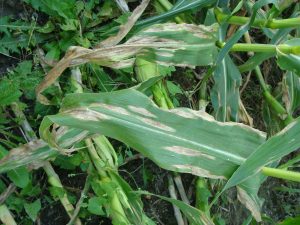
Northern corn leaf blight: This fungus disease has become more prevalent across New England in recent years, and growers should monitor fields for the symptoms. Gray to tan cigar-shaped lesions appear on the leaves and stalks, eventually coalescing, causing the leaves to die and dry up. This weakens the plants, reducing yield and quality of the ears. To manage the disease, purchase only varieties that are resistant to leaf blight, rotate out of fields that have had the disease for at least one year, and when necessary apply fungicides when symptoms are first noticed. For more information, including products and rates, consult the New England Vegetable Management Guide.
Do-It-Yourself IPM: To get the most accurate information about the pest situation on your farm you should monitor the fields yourself on a regular basis. Pheromone traps and lures are available that can give you an accurate, early warning of the arrival of all of the major insect pests. Traps and lures can be purchased from pest management supply companies such as Gempler’s (1.800.382.8473) or Great Lakes IPM (517.268.5693). You may also want to download a copy of our fact sheet Managing Insect Pests of Sweet Corn at our website.
- European Corn Borer Trap; photo by David Handley
- Harstack Trap; photo by David Handley
Sincerely,
David T. Handley
Vegetable and Small Fruit Specialist
Highmoor Farm, P.O. Box 179, 52 US Route 202, Monmouth, ME 04259, 207.933.2100
UMaine Extension Diagnostic Research Lab, Pest Management Unit, 17 Godfrey Drive, Orono, ME 04473, 1.800.287.0279
IPM Web Pages:
UMaine Cooperative Extension Integrated Pest Management
UMass Amherst Integrated Pest Management
Where brand names or company names are used, it is for the reader’s information. No endorsement is implied nor is any discrimination intended against other products with similar ingredients. Always consult product labels for rates, application instructions and safety precautions. Users of these products assume all associated risks.
The University of Maine is an equal opportunity/affirmative action institution.

